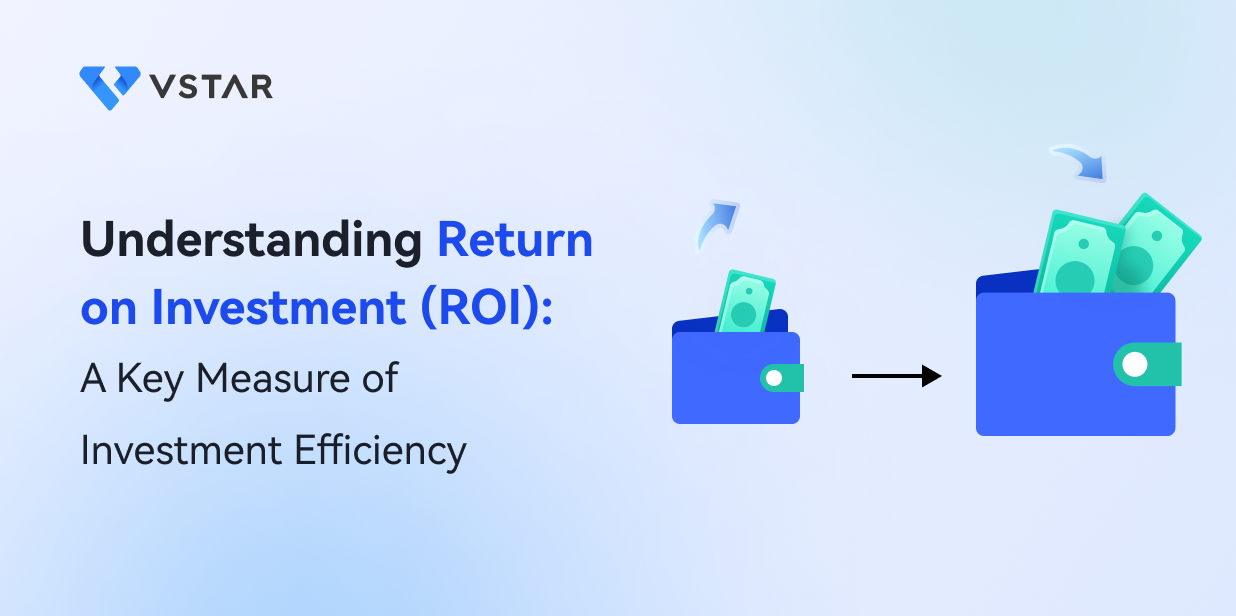We go into the idea of Return on Investment (ROI), a key financial metric used to assess the effectiveness of an investment, in this extensive guide. We examine why and how ROI is a key tool in making investment decisions, starting with its fundamental definition and calculation across different investment kinds. We also go over ways to maximize return on investment (ROI) and the significance of taking other metrics into account to fully comprehend the potential profitability of an investment. This essay can help individual and corporate investors improve their financial decision-making processes. Whether you're a first-time investor or a seasoned pro, you'll find this investigation of ROI helpful on your path to monetary success and progress.
What is ROI

A fundamental financial metric known as return on investment (ROI) is frequently used to assess the likelihood of profiting from an investment. A gain or loss from an investment about its cost is compared using this ratio. The main goal of ROI is to assess how effectively various investments produce profits.
The ROI calculation formula is easy to understand:
ROI is calculated as (Gain from Investment - Cost of Investment) / Investment Cost.
ROI measures the size of an investment's returns concerning its cost and is expressed as a percentage. A profitable investment is one with a positive ROI; one with a negative ROI is one that lost money.
An essential tool for making investment decisions is ROI. It aids investors in deciding whether an investment opportunity is worthwhile, including private persons and businesses. The higher the ROI, the higher the predicted returns for each dollar invested in the investment. Consequently, given the possibility of greater returns, investors favor projects with high ROIs.
The adaptability of ROI as a financial statistic is one of its main advantages. The same units assess benefits and expenses, providing a consistent basis for comparison. Depending on the needs of the review, this consistency can be used annually or throughout the investment. As a result, ROI offers a consistent approach for assessing and contrasting the efficacy of various investment kinds, even when they are dissimilar.
For instance, an investor can utilize ROI to analyze the performance of real estate, stock market investments, and small business ventures. By describing the value of returns about the investment cost, ROI enables a direct performance comparison notwithstanding these investments' different natures and risk profiles.
At the end of the day, return on investment (ROI) is an important financial term that enables investors to assess an investment's effectiveness or to compare the efficacy of multiple distinct assets. It offers a quantitative foundation for deliberation, assisting investors in maximizing returns. However, to get a whole picture of an investment's prospective profitability, other metrics should be employed in addition to ROI, just like with any other financial indicator.
Why Measure ROI?

When making investment decisions, Return on Investment (ROI) is a crucial measure that offers individuals and organizations essential insights. Numerous significant advantages that aid in the strategic allocation of resources, performance evaluation, and return maximization are provided by measuring ROI.
First, considering the risks and other available options, ROI is crucial for assessing if an investment produces reasonable returns. Investors can avoid projects that don't produce the returns they want by establishing a minimum ROI criterion for any new investment based on their financial objectives. This ensures that investments match their risk tolerance and financial goals.
Second, ROI makes it possible to compare various investments and determine which ones offer the best returns. Ranking potential investments by their ROI is a strategic strategy to deploy cash most effectively, especially when resources are scarce. With the help of this technique, investors may maximize the return on their investment budget.
Thirdly, ROI is crucial for tracking an investment's progress over time. Investors can decide whether to continue with an investment or to sell it by monitoring its return on investment (ROI). An investment's ROI may indicate a need for change, such as re-evaluating the investment strategy or reallocating funds to more lucrative endeavors if it is low or falling.
Finally, ROI measures how effectively a business or fund manager produces returns on invested money. It is wise for investors who want to optimize their returns to choose investments or fund managers who consistently show strong ROI. This suggests high proficiency in using capital and making a profit.
Although ROI is a crucial tool, it's necessary to keep in mind that it shouldn't be utilized alone. Other indicators and elements like the investment's level of risk, the investment horizon, and the investor's financial objectives should also be considered. ROI also measures past performance and cannot predict future outcomes. Therefore, investors should consider various aspects, including ROI, to make balanced and knowledgeable investment selections.
In the end, quantifying ROI is essential for determining the effectiveness of an investment, comparing alternative investments, monitoring performance over time, and analyzing a company's or fund manager's skill in creating returns. It is a potent instrument that supports optimizing returns and strategic investment decisions.
How to Calculate ROI

To determine if an investment will be profitable, return on investment (ROI) must be calculated. Here's how to determine ROI for various investment types:
Direct Investment: Determine your gain or loss before making any direct investments, such as outright purchases of stocks, bonds, or real estate. Any monetary disbursements, such as dividends or rental revenue, are included in this. Take away your initial investment cost—which should consist of transaction fees—away from this. Your net gain or loss is the resulting amount. Divide this number by the amount of your initial investment to compute ROI. Your ROI is the outcome, which is typically presented as a percentage.
Managed Investments: The calculating procedure differs slightly for managed investments like mutual funds, exchange-traded funds (ETFs), or retirement accounts. Calculate your annualized returns from inception first, using the share price as of the current day plus any distributions. Subtract any fees or expenses that the fund management deducted from this. Divide this net annualized return by your initial investment to determine your ROI. You will receive the ROI for the investment's whole life up to the present by doing this.
Trading: The computation of ROI entails a few extra procedures for those who often buy and sell assets, such as day traders. Add up your net winnings from all closed positions to start. Subtract all transactional expenses, including broker fees, spreads, and overnight funding charges. Then, to calculate your ROI, divide this net profit amount by your typical investment level or starting capital. Depending on your trading strategy and average holding duration, you may calculate ROI over days, weeks, or months.
ROI is a potent tool that enables investors to assess the effectiveness of all types of investments. Calculating ROI is crucial for making wise judgments while dealing with direct investments, managed investments, or engaging in frequent trading. Though ROI is a helpful indicator, remember that it should be used with other tools and indicators to evaluate an investment's performance thoroughly.
Maximizing Your ROI

Maximizing your ROI is crucial to get the most out of your financial investments. Following are some recommendations to help you increase your ROI:
Choosing Higher-Potential Investments: Invest in Securities with a Higher Potential: Choose securities with a higher potential for return, such as equities over bonds or managed funds over savings accounts. But keep in mind that larger risks frequently accompany higher profits. Before making an investment decision, consider the prospective risk compared to the potential rewards.
Invest with a Margin of Safety: Consider purchasing undervalued or discounted investments, providing a margin of safety, especially when planning to retain assets for a long time. These choices have high upside potential, increasing your return on investment.
Reduce expenses: High transaction expenses might dilute your gains and hurt your ROI. To reduce transaction costs, use low-fee brokers and fund managers, trade or rebalance less frequently, and use tax-efficient ways to keep more of your earnings.
Diversify Your Portfolio: To balance risk and return, diversify your portfolio by spreading your money over various investment vehicles, including cash, stocks, and real estate. To keep this balance and increase your total ROI, regularly evaluate your portfolio and adjust it when market conditions change.
Regularly Review Your Investments: Reviewing your investments regularly will help you spot potential areas for development. Consider switching if there are other investment opportunities with more significant potential returns. Make sure the change won't dramatically raise your risk exposure, though.
Take Profits at the Right Moments: It's critical to protect gains during market downturns and lock in profits during high-return periods. This necessitates a methodical approach to selling your investments and taking profits when they reach predefined price levels. When fresh high ROI chances present themselves, reinvest these gains.
These recommendations can improve your ROI and make your investing journey more fruitful and profitable. However, it's critical to remember that investment choices should be supported by in-depth study and, when necessary, expert guidance.
Conclusion
Understanding and calculating Return on Investment (ROI) is essential to successful investing. It provides a measure of the efficiency of an investment, helping investors make informed decisions about where to allocate their resources. The ability to calculate and interpret ROI allows for a standardized comparison of disparate investments, thereby aiding in choosing between various investment options.
ROI isn’t just a one-time measure; it’s also a tool for ongoing investment performance monitoring. By tracking an investment's ROI, investors can decide whether to stick with or exit an investment. It can also signal when a change is needed, such as reallocating resources to more lucrative opportunities. Furthermore, ROI indicates how effectively a company or fund manager generates returns from capital invested, which is essential for investors aiming to maximize their returns.
To maximize ROI, investors must adopt strategies that include choosing higher potential investments, investing with a margin of safety, minimizing costs, diversifying their portfolio, regularly reviewing their investments, and taking profits at opportune moments. Doing so can increase their chances of achieving financial goals and ensure their investment journey is more productive and profitable.
However, while ROI is a powerful tool, it should not be used in isolation. It's also critical to consider other factors such as risk level, investment horizon, and personal financial goals. Like any other economic indicator, ROI is a part of the bigger picture and should be used with other metrics for a holistic view of an investment’s potential profitability. Remember, as with all investment strategies, thorough research and, when necessary, professional advice are key to success.



